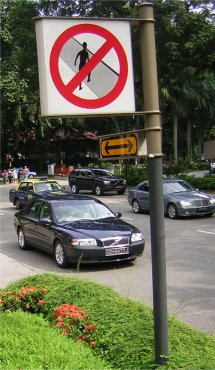
Back العبور العشوائي للمشاة Arabic Jaywalking French Menyeberang sembarangan ID 무단횡단 Korean Jaywalking Dutch Rågjengeri NB Jaywalking SIMPLE Labag na pagtawid Tagalog

Jaywalking is the act of pedestrians walking in or crossing a roadway if that act contravenes traffic regulations. The term originated in the United States as a derivation of the phrase jay-drivers (the word jay meaning 'a greenhorn, or rube'[1]), people who drove horse-drawn carriages and automobiles on the wrong side of the road, before taking its current meaning. Jaywalking was coined as the automobile arrived in the street in the context of the conflict between pedestrian and automobiles (also then known as horseless carriages), more specifically the nascent automobile industry.[2][3]
Jaywalking laws vary widely by jurisdiction. In many countries, the word is not generally used and, with the exception of certain high-speed roads such as motorways, there are no laws limiting how pedestrians are allowed to cross public highways. Thus, globally speaking, legal texts use different concepts, one of which is Rules applicable to pedestrians, put forward by the Vienna Convention on Road Traffic.[4] As an example of the subtleties and discrepancies of the laws governing pedestrian road traffic, even as a signing member of the Vienna convention, the United Kingdom does not have jaywalking laws: its Highway Code relies on the pedestrians making their own judgment on whether it is safe to cross based on the Green Cross Code.
- ^ "Why Jaywalking is Called Jaywalking". Merriam Webster. Retrieved September 10, 2017.
- ^ Norton, Peter D. (April 2, 2007). "Street Rivals: Jaywalking and the Invention of the Motor Age Street". Project MUSE. Technology and Culture. 48 (2). Johns Hopkins University Press: 331–359. doi:10.1353/tech.2007.0085. S2CID 144015588. Retrieved May 27, 2021.
- ^ Norton, Peter D. (2008). Fighting Traffic: The Dawn of the Motor Age in the American City. Inside Technology. MIT Press. p. 408. ISBN 978-0-262-28075-4. JSTOR j.ctt5hhckp.
- ^ "Vienna Convention on Road Traffic (Amendment 1, 1968-11-08)" (PDF). United Nations Economic Commission for Europe (UNECE). November 8, 1968.